Linearization as a Solution for Power Amplifier Imperfections: A Review of Methods
Abstract
:1. Introduction
2. Overview
2.1. Feedforward Linearization
2.2. Feedback Linearization
2.3. Predistortion Linearization
3. Discussion
4. Conclusions
Author Contributions
Funding
Acknowledgments
Conflicts of Interest
Abbreviations
| Abbreviations used in this paper | |
| ADC | Analog to digital converter |
| AM | Amplitude modulation |
| ACLR | Adjacent channel leakage ratio |
| ASIC | Application-specific integrated circuit |
| CMOS | Complementary metal-oxide semiconductor |
| DAC | Digital to analog converter |
| DPD | Digital predistortion |
| EDGE | Enhanced data rates for GSM evolution |
| EVM | Error vector module |
| FPGA | Field-programmable gate array |
| GMP | General memory polynomial |
| GaN | Gallium nitride |
| GaN-HEMT | Gallium nitride high-electron-mobility transistor |
| GaAs | Gallium arsenide |
| GPU | Graphical processor unit |
| HEMT | High-electron-mobility transistor |
| HPA | High power amplifier |
| GSM | Global system for mobile communications |
| IM | Intermodulation |
| IF | Intermediate frequency |
| LTE | Long-term evolution |
| LTE-A | LTE advanced |
| LUT | Look-up table |
| LDMOS | Laterally-diffused metal-oxide semiconductor |
| MIMO | Multiple input multiple output |
| mMIMO | Massive MIMO |
| MRAS | Model reference advanced system |
| MPP | Memory polynomial model |
| OFDM | Orthogonal frequency division multiplexing |
| PAE | Power added efficiency |
| PAPR | Peak to average power ratio |
| PM | Phase modulation |
| PLL | Phase locked loop |
| PA | Power amplifier |
| PS | Phase shift |
| QAM | Quadrature amplitude modulation |
| RF | Radio frequency |
| SiGe | Silicon germanium |
| Si-LDMOS | Silicon laterally-diffused metal-oxide semiconductor |
| SOI CMOS | Silicon on insulator complementary metal-oxide semiconductor |
| STR | Self-tuning regulator |
| SFDR | Spurious free dynamic range |
| TWT | Traveling wave tube |
| VCO | Voltage-controlled oscillator |
| WCDMA | Wideband code division multiple access |
| 4G | Fourth generation |
| 5G | Fifth generation |
| Symbols used in figures and equations of this paper | |
| A | Analog amplifier gain |
| B | Analog couplers coupling ratio |
| C1, C2 | Active feedback couplers |
| G | Digital system gain |
| S point, Q point | Power amplifier saturation and quiescent points |
| IMSRa, IMSR0 | Ratio of intermodulation power to signal power before and after the error cancellation circuit |
| β | Feedback constant |
| ai, aMRAS,i, aSTR,i | DPD, MRAS-DPD and STR-DPD coefficients |
| Tdn | Delay time of time-delay element |
| τ | Maximal delay time error in feedforward circuit |
| Pin, Pout | Input and output power |
| V, Vout | Input and output voltages of feedback amplifier |
| kn | n-th harmonic coefficient of nonlinear system |
| x(t), y(t), yRF(t) | Input and output analog signals |
| xI(t), xQ(t) | In-phase and quadrature signal components |
| x(n), xDPD(n), xSTR(n) y(n) | input, DPD output, STR output and output digital signals |
| z(n), e(n) | Output and error signal of post-inverse adaptive filter |
References
- The European Conference of Postal and Telecommunications Administrations CEPT. Available online: https://cept.org/ecc/topics/spectrum-for-wireless-broadband-5g (accessed on 3 April 2020).
- Lie, D.; Mayeda, J.C.; Lopez, J. Highly efficient 5G linear power amplifiers (PA) design challenges. In Proceedings of the International Symposium on VLSI Design, Automation and Test (VLSI-DAT), Hsinchu, Taiwan, 24–27 April 2017. [Google Scholar]
- Vasjanov, A.; Barzdenas, V. A Review of advanced CMOS RF power amplifier architecture trends for low power 5G wireless networks. Electronics 2018, 7, 271. [Google Scholar] [CrossRef] [Green Version]
- Black, H.S. Inventing the negative feedback amplifier: Six years of persistent search helped the author conceive the idea “in a flash” aboard the old Lackawanna ferry. IEEE Spectr. 1977, 14, 55–60. [Google Scholar] [CrossRef]
- Pothecary, N. Feedforward Linear Power Amplifiers; Artech House Microwave Library; Artech House: London, UK, 1999; ISBN 9781580530224. [Google Scholar]
- Bennett, T.J.; Clements, R.F. Feedforward—An alternative approach to amplifier linearization. Radio Electron. Eng. 1974, 44, 257–262. [Google Scholar] [CrossRef]
- Seidel, H.; Beurrier, H.R.; Friedman, A.N. Error-controlled high power linear amplifiers at VHF. Bell Syst. Tech. J. 1968, 47, 651–722. [Google Scholar] [CrossRef]
- Kenington, P.B. Efficiency of feedforward amplifiers. IEE Proc. Part. G Circuits Devices Syst. 1992, 139, 591–593. [Google Scholar] [CrossRef]
- Parsons, K.J.; Kenington, P.B. The efficiency of a feedforward amplifier with delay loss. IEEE Trans. Veh. Technol. 1994, 43, 407–412. [Google Scholar] [CrossRef]
- Cavers, J.K. Adaptation behavior of a feedforward amplifier linearizer. IEEE Trans. Veh. Technol. 1995, 44, 31–40. [Google Scholar] [CrossRef]
- Smith, A.M.; Cavers, J.K. A Wideband architecture for adaptive feedforward linearization. In Proceedings of the IEEE Vehicular Technology Conference, Ottawa, ON, Canada, 21 May 1998; pp. 2488–2492. [Google Scholar]
- Gokceoglu, A.; Ghadam, A.; Valkama, M. Steady-state performance analysis and step-size selection for LMS-adaptive wideband feedforward power amplifier linearizer. IEEE Trans. Signal. Process. 2012, 60, 82–99. [Google Scholar] [CrossRef]
- Braithwaite, R.N.; Hunton, M.J. A positive feedback pilot system for a wide bandwidth feedforward amplifier. In Proceedings of the 3rd European Wireless Technology Conference, Paris, France, 27–28 September 2010; pp. 1778–1781. [Google Scholar]
- Cho, K.J.; Kim, J.H.; Stapleton, S.P. A highly efficient doherty feedforward linear power amplifier for W-CDMA base-station applications. IEEE Trans. Microw. Theory Tech. 2005, 53, 292–300. [Google Scholar] [CrossRef]
- Xiang, Y.B.; Wang, G.M. Doherty power amplifier with feedforward linearization. In Proceedings of the APMC 2009—Asia Pacific Microwave Conference, Singapore, 7–10 December 2009; pp. 1621–1624. [Google Scholar]
- Choi, H.; Jeong, Y.; Kim, C.D.; Kenney, J.S. Efficiency enhancement of feedforward amplifiers by employing a negative group-delay circuit. IEEE Trans. Microw. Theory Tech. 2010, 58, 1116–1125. [Google Scholar] [CrossRef]
- Braithwaite, R.N.; Khanifar, A. High efficiency feedforward power amplifier using a nonlinear error amplifier and offset alignment control. In Proceedings of the IEEE MTT-S International Microwave Symposium Digest, Seattle, WA, USA, 2–7 June 2013; pp. 21–24. [Google Scholar]
- Braithwaite, R.N. A comparison for a doherty power amplifier linearized using digital predistortion and feedforward compensation. In Proceedings of the 2015 IEEE MTT-S International Microwave Symposium, IMS 2015, Phoenix, AZ, USA, 17–22 May 2015. [Google Scholar]
- Denny, H.W. Linearization techniques for broadband transistor amplifiers. In Proceedings of the 1970 IEEE Electromagnetic Compatibility Symposium Record, Anaheim, CA, USA, 14–16 July 1970; pp. 1–10. [Google Scholar]
- Kenington, P.B. High Linearity RF Amplifier Design; Artech House: Boston, MA, USA; London, UK, 2000. [Google Scholar]
- Raab, F.H.; Asbeck, P.; Cripps, S.; Kenington, P.B.; Popović, Z.B.; Pothecary, N.; Sevic, J.F.; Sokal, N.O. Power amplifiers and transmitters for RF and microwave. IEEE Trans. Microw. Theory Tech. 2002, 50, 814–826. [Google Scholar] [CrossRef] [Green Version]
- Wood, J. Behavioral Modeling and Linearization of RF Power Amplifiers; Artech House Microwave Library; Artech House: London, UK, 2014; ISBN 9781608071203. [Google Scholar]
- Ballesteros, E.; Perez, F.; Perez, J. Analysis and design of microwave linearized amplifiers using active feedback. IEEE Trans. Microw. Theory Tech. 1988, 36, 499–504. [Google Scholar] [CrossRef]
- Perez, F.; Ballesteros, E.; Perez, J. Linearisation of microwave power amplifiers using active feedback networks. Electron. Lett. 1985, 21, 9–10. [Google Scholar] [CrossRef]
- Pedro, J.C.; Perez, J. An MMIC linearized amplifier using active feedback. In Proceedings of the 1993 IEEE MTT-S International Microwave Symposium Digest, Atlanta, GA, USA, 14–15 June 1993; pp. 95–98. [Google Scholar]
- Liu, J.; Cao, C.; Li, Y.; Tan, T.; Chen, D.; Huang, Z.; Li, X. A broadband CMOS high efficiency power amplifier with large signal linearization. In Proceedings of the 2019 IEEE Asia-Pacific Microwave Conference (APMC), Singapore, 10–13 December 2019; pp. 1155–1157. [Google Scholar] [CrossRef]
- Kang, S.; Baek, D.; Hong, S. A 5-GHz WLAN RF CMOS power amplifier with a parallel-cascoded configuration and an active feedback linearizer. IEEE Trans. Microw. Theory Tech. 2017, 65, 3230–3244. [Google Scholar] [CrossRef]
- Kang, S.; Sung, E.T.; Hong, S. Dynamic feedback linearizer of RF CMOS power amplifier. IEEE Microw. Wirel. Compon. Lett. 2018, 28, 915–918. [Google Scholar] [CrossRef]
- Xu, K. Silicon electro-optic micro-modulator fabricated in standard CMOS technology as components for all silicon monolithic integrated optoelectronic systems. J. Micromech. Microeng. 2021, 31, 054001. [Google Scholar] [CrossRef]
- Macchiarella, G.; Iommi, R.; Galli, S.; Delzanno, A. Study and experiment of a novel class of error envelope feedback linearizers. In Proceedings of the European Microwave Conference, Amsterdam, The Netherlands, 12–14 October 2004; Volume 2, pp. 1057–1060. [Google Scholar]
- Petrovic, V.; Gosling, W. Polar-loop transmitter. Electron. Lett. 1979, 15, 286–288. [Google Scholar] [CrossRef]
- Li, P.; Song, Z.; Lin, J.; Wei, M.; Guo, F.; Jia, W.; Wang, Z.; Chi, B. A reconfigurable digital polar transmitter with open-loop phase modulation for Sub-GHz applications. In Proceedings of the IEEE International Symposium on Industrial Electronics, Santa Clara, CA, USA, 8–10 June 2016; Volume 2016, pp. 1158–1161. [Google Scholar]
- Geng, Z.; Xie, Y.; Zhuang, L.; Burla, M.; Hoekman, M.; Roeloffzen, C.G.H.; Lowery, A.J. Photonic integrated circuit implementation of a Sub-GHz-selectivity frequency comb filter for optical clock multiplication. Opt. Express 2017, 25, 27635. [Google Scholar] [CrossRef] [PubMed] [Green Version]
- Zheng, S.; Luong, H.C. A CMOS WCDMA/WLAN digital polar transmitter with AM replica feedback linearization. IEEE J. Solid-State Circuits 2013, 48, 1701–1709. [Google Scholar] [CrossRef]
- Kousai, S.; Onizuka, K.; Yamaguchi, T.; Kuriyama, Y.; Nagaoka, M. A 28.3 MW PA-closed loop for linearity and efficiency improvement integrated in a + 27.1 DBm WCDMA CMOS power amplifier. In Proceedings of the 2012 IEEE International Solid-State Circuits Conference, San Francisco, CA, USA, 19–23 February 2012; Volume 47, pp. 2964–2973. [Google Scholar]
- Katz, A.; Wood, J.; Chokola, D. The evolution of PA linearization: From classic feedforward and feedback through analog and digital predistortion. IEEE Microw. Mag. 2016, 17, 32–40. [Google Scholar] [CrossRef]
- Dawson, J.L.; Lee, T.H. Feedback Linearization of RF Power Amplifiers; Kluwer Academic Publishers: Amsterdam, The Netherlands, 2004; ISBN 1-4020-8062-X. [Google Scholar]
- Faulkner, M.; Briffa, M.A. Amplifier linearisation using RF feedback and feedforward techniques. IEEE Trans. Veh. Technol. 1998, 47, 209–215. [Google Scholar] [CrossRef]
- Faulkner, M.; Briffa, M.A. Stability analysis of cartesian feedback linearisation for amplifiers with weak nonlinearities. IEE Proc. Commun. 1996, 143, 212–218. [Google Scholar] [CrossRef]
- Faulkner, M. An automatic phase adjustment scheme for RF and cartesian feedback linearizers. IEEE Trans. Veh. Technol. 2000, 49, 956–964. [Google Scholar] [CrossRef]
- Briffa, M.; Faulkner, M. Dynamically biased cartesian feedback linearization. In Proceedings of the IEEE Vehicular Technology Conference, Secaucus, NJ, USA, 18–20 May 1993; pp. 672–675. [Google Scholar]
- Li, J.; Xu, Z.; Hong, W.; Gu, Q.J. A low-noise cartesian error feedback architecture. IEEE Trans. Circuits Syst. I Regul. Pap. 2018, 65, 1133–1142. [Google Scholar] [CrossRef]
- Ock, S.; Song, H.; Gharpurey, R. A cartesian feedback-feedforward transmitter IC in 130nm CMOS. In Proceedings of the Custom Integrated Circuits Conference, San Jose, CA, USA, 28–30 September 2015; Volume 2015, pp. 31–34. [Google Scholar]
- Li, J.; Shu, R.; Gu, Q.J. A fully-integrated cartesian feedback loop transmitter in 65nm CMOS. In Proceedings of the IEEE MTT-S International Microwave Symposium Digest, Honololu, HI, USA, 4–9 June 2017; pp. 103–106. [Google Scholar]
- Delaunay, N.; Deltimple, N.; Belot, D.; Kerhervé, E. Linearization of a 65 nm CMOS power amplifier with a cartesian feedback for W-CDMA standard. In Proceedings of the 2009 Joint IEEE North-East Workshop on Circuits and Systems and TAISA Conference, NEWCAS-TAISA’09, Toulouse, France, 28 June–1 July 2009; pp. 2–5. [Google Scholar]
- Li, J.; Xu, Z.; Gu, Q.J. A 21dBm-OP1dB 20.3%-efficiency-131.8dBm/Hz-noise X-band cartesian-error-feedback transmitter with fully integrated power amplifier in 65nm CMOS. In Proceedings of the Digest of Technical Papers—IEEE International Solid-State Circuits Conference, San Francisco, CA, USA, 17–21 February 2019; pp. 452–454. [Google Scholar]
- Fakhrutdinov, R.R.; Zavyalov, S.A.; Murasov, K.V.; Liashuk, A.N. Integrated cartesian feedback with automatic phase adjustment and power amplifier. In Proceedings of the International Conference of Young Specialists on Micro/Nanotechnologies and Electron Devices, EDM, Chemal, Russia, 29 June–3 July 2020. [Google Scholar]
- Ishihara, H.; Hosoya, M.; Otaka, S.; Watanabe, O. A 10-MHz signal bandwidth cartesian loop tansmitter capable of off-chip PA linearization. IEEE J. Solid-State Circuits 2010, 45, 2785–2793. [Google Scholar] [CrossRef]
- Lenz, S. Linearization of radio-relay transmitters by a predistortion upconverter. In Proceedings of the 1981 11th European Microwave Conference, Amsterdam, The Netherlands, 7–11 September 1981; pp. 209–214. [Google Scholar]
- Holz, W. An IF-predistorter for TWTA-linearization in 16 QAM digital radio. In Proceedings of the 1984 14th European Microwave Conference, Liege, Belgium, 10–13 September 1984; pp. 543–548. [Google Scholar]
- Stewart, R.D.; Tusuriba, F.F. Predistortion linearisation of amplifiers for UHF mobile radio. In Proceedings of the 1988 18th European Microwave Conference, Stockholm, Sweden, 12–15 September 1988; pp. 1017–1022. [Google Scholar]
- Bateman, A.; Wilkinson, R.J.; Marvill, J.D. The application of digital signal processing to transmitter linearisation. In Proceedings of the 8th European Conference on Electrotechnics, Conference Proceedings on Area Communication, Stockholm, Sweden, 13–17 June 1988; pp. 64–67. [Google Scholar]
- Feher, K. A new generation of 90 Mb/s systems: Bandwidth efficient, field tested 16-QAM. IEEE Trans. Broadcast. 1989, 35, 23–30. [Google Scholar] [CrossRef]
- Faulkner, M.; Mattson, T.; Yates, W. Adaptive linearisation using pre-distortion. In Proceedings of the 40th IEEE Conference on Vehicular Technology, Orlando, FL, USA, 6–9 May 1990; pp. 35–40. [Google Scholar]
- Sun, J.; Li, B.; Chia, Y.W.M. A novel CDMA power amplifier for high efficiency and linearity. In Proceedings of the IEEE Vehicular Technology Conference, Amsterdam, The Netherlands, 19–22 September 1999; pp. 2044–2047. [Google Scholar]
- Yamauchi, K.; Mori, K.; Nakayama, M.; Itoh, Y.; Mitsui, Y.; Ishida, O. A novel series diode linearizer for mobile radio power amplifiers. In Proceedings of the IEEE MTT-S International Microwave Symposium Digest, San Francisco, CA, USA, 17–21 June 1996; pp. 831–834. [Google Scholar]
- Braithwaite, R.N. General principles and design overview of digital predistortion. In Digital Front-End in Wireless Communications and Broadcasting; Luo, F.-L., Ed.; Cambridge University Press: Cambridge, UK, 2011; pp. 143–191. ISBN 9780511744839. [Google Scholar]
- Wood, J. System-level design considerations for digital pre-distortion of wireless base station transmitters. IEEE Trans. Microw. Theory Tech. 2017, 65, 1880–1890. [Google Scholar] [CrossRef]
- Cavers, J.K. Amplifier linearization using a digital predistorter with fast adaptation and low memory requirements. IEEE Trans. Veh. Technol. 1990, 39, 374–382. [Google Scholar] [CrossRef]
- Zhou, D.; DeBrunner, V. A novel adaptive nonlinear predistorter based on the direct learning algorithm. IEEE Trans. Signal. Process. 2007, 55, 120–133. [Google Scholar] [CrossRef]
- Beltagy, Y.; Mitran, P.; Boumaiza, S. Direct Learning algorithm for digital predistortion training using sub-nyquist intermediate frequency feedback signal. IEEE Trans. Microw. Theory Tech. 2019, 67, 267–277. [Google Scholar] [CrossRef]
- Eun, C.; Powers, E.J. A new volterra predistorter based on the indirect learning architecture. IEEE Trans. Signal. Process. 1997, 45, 223–227. [Google Scholar] [CrossRef]
- Ding, L.; Zhou, G.T.; Morgan, D.R.; Ma, Z.; Kenney, J.S.; Kim, J.; Giardina, C.R. Memory Polynomial predistorter based on the indirect learning architecture. In Proceedings of the Conference Record/IEEE Global Telecommunications Conference, Taipei, Taiwan, 17–21 November 2002. [Google Scholar]
- Yu, C.; Tang, Q.; Liu, Y. A novel indirect learning digital predistortion architecture only with in-phase component. In Proceedings of the Asia-Pacific Microwave Conference, APMC, Kyoto, Japan, 16 January 2019; Volume 2018, pp. 995–997. [Google Scholar]
- Psaltis, D.; Sideris, A.; Yamamura, A.A. A multilayered neural network controller. IEEE Control. Syst. Mag. 1988, 8, 17–21. [Google Scholar] [CrossRef]
- Muhonen, K.J.; Kavehrad, M.; Krishnamoorthy, R. Look-up table techniques for adaptive digital predistortion: A development and comparison. IEEE Trans. Veh. Technol. 2000, 49, 1995–2002. [Google Scholar] [CrossRef]
- Gilabert, P.L.; Cesari, A.; Montoro, G.; Bertran, E.; Dilhac, J.M. Multi-lookup table FPGA implementation of an adaptive digital predistorter for linearizing RF power amplifiers with memory effects. IEEE Trans. Microw. Theory Tech. 2008, 56, 372–384. [Google Scholar] [CrossRef]
- Benedetto, S.; Biglieri, E.; Daffara, R. Modeling and performance evaluation of nonlinear satellite links-a volterra series approach. IEEE Trans. Aerosp. Electron. Syst. 1979, AES-15, 494–507. [Google Scholar] [CrossRef]
- Ding, L. Digital Predistortion of Power Amplifiers for Wireless Applications; Georgia Institute of Technology: Atlanta, GA, USA, 2004. [Google Scholar]
- Morgan, D.R.; Ma, Z.; Kim, J.; Zierdt, M.G.; Pastalan, J. A generalized memory polynomial model for digital predistortion of RF power amplifiers. IEEE Trans. Signal. Process. 2006, 54, 3852–3860. [Google Scholar] [CrossRef]
- Ghannouchi, F.M.; Hammi, O.; Helaoui, M. Behavioral Modeling and Predistortion of Wideband Wireless Transmitters; Wiley: Hoboken, NJ, USA, 2015; ISBN 9781118406274. [Google Scholar]
- Ghosh, A.; Ratasuk, R.; Mondal, B.; Mangalvedhe, N.; Thomas, T. LTE-advanced: Next-generation wireless broadband technology. IEEE Wirel. Commun. 2010, 17, 10–22. [Google Scholar] [CrossRef]
- Hu, Y.; Boumaiza, S. Power-scalable wideband linearization of power amplifiers. IEEE Trans. Microw. Theory Tech. 2016, 64, 1456–1464. [Google Scholar] [CrossRef]
- Bondar, D.; Lopez, N.D.; Popovic, Z.; Budimir, D. Linearization of high-efficiency power amplifiers using digital baseband predistortion with iterative injection. In Proceedings of the 2010 IEEE Radio and Wireless Symposium, New Orleans, LA, USA, 10–14 January 2010; pp. 148–151. [Google Scholar]
- Gilabert, P.L.; Vegas, D.; Ren, Z.; Montoro, G.; Perez-Cisneros, J.R.; Ruiz, M.N.; Si, X.; Garcia, J.A. Design and digital predistortion linearization of a wideband outphasing amplifier supporting 200 MHz bandwidth. In Proceedings of the 2020 IEEE Topical Conference on RF/Microwave Power Amplifiers for Radio and Wireless Applications, PAWR 2020, San Antonio, TX, USA, 26–29 January 2020; pp. 46–49. [Google Scholar]
- Tian, T.; Zhao, Y.; Dou, Y.; Yu, C.; Qiu, J. A novel concurrent tri-band digital predistortion for broadband signals. In Proceedings of the 45th European Microwave Conference Proceedings, EuMC, Paris, France, 7–10 September 2015; pp. 1136–1139. [Google Scholar]
- Jung, Y.; Fritzin, J.; Enqvist, M.; Alvandpour, A. Least-squares phase predistortion of a +30 DBm class-D outphasing RF PA in 65 Nm CMOS. IEEE Trans. Circuits Syst. I Regul. Pap. 2013, 60, 1915–1928. [Google Scholar] [CrossRef] [Green Version]
- Wang, S.; Hussein, M.A.; Venard, O.; Baudoin, G. Impact of the normalization gain of digital predistortion on linearization performance and power added efficiency of the linearized power amplifier. In Proceedings of the 47th European Microwave Conference EuMC 2017, Nuremberg, Germany, 10–12 October 2017; pp. 1050–1053. [Google Scholar]
- Wolf, N.; Heinrich, W.; Bengtsson, O. A novel model for digital predistortion of discrete level supply-modulated RF power amplifiers. IEEE Microw. Wirel. Compon. Lett. 2016, 26, 146–148. [Google Scholar] [CrossRef]
- Rostomyan, N.; Jayamon, J.A.; Asbeck, P.M. 15 GHz doherty power amplifier with RF predistortion linearizer in CMOS SOI. IEEE Trans. Microw. Theory Tech. 2018, 66, 1339–1348. [Google Scholar] [CrossRef]
- Ali, S.N.; Agarwal, P.; Gopal, S.; Heo, D. Transformer-based predistortion linearizer for high linearity and high modulation efficiency in Mm-Wave 5G CMOS power amplifiers. IEEE Trans. Microw. Theory Tech. 2019, 67, 3074–3087. [Google Scholar] [CrossRef]
- Tsai, J.H.; Wu, C.H.; Yang, H.Y.; Huang, T.W. A 60 GHz CMOS power amplifier with built-in pre-distortion linearizer. IEEE Microw. Wirel. Compon. Lett. 2011, 21, 676–678. [Google Scholar] [CrossRef]
- Bremenson, C.; Palazo, M.; Neyer, R. Linearizing TWT amplifiers in satellite transponders, systems aspects and practical implementation. In Proceedings of the 8th Communications Satellite Systems Conference, Orlando, FL, USA, 20–24 April 1980; pp. 80–89. [Google Scholar]
- Bremenson, C.; Lombard, D. Linearization of a satellite transmission channel in a time division multiple access system. In Proceedings of the 3rd International Conference on Digital Satellite Communications, Kyoto, Japan, 11–13 November 1975; pp. 144–151. [Google Scholar]
- Whartenby, J.C.; Wolkstein, H.J. Predistortion linearizer using GaAs dual-gate MESFET for TWTA and SSPA used in satellite transponders. IEEE Trans. Microw. Theory Tech. 1985, 33, 1479–1488. [Google Scholar] [CrossRef]
- Li, H.; Jiang, T.; Zhou, Y. An improved tone reservation scheme with fast convergence for PAPR reduction in OFDM systems. IEEE Trans. Broadcast. 2011, 57, 902–906. [Google Scholar] [CrossRef]
- Bulusu, S.S.K.C.; Shaiek, H.; Roviras, D.; Zayani, R. Reduction of PAPR for FBMC-OQAM systems using dispersive SLM technique. In Proceedings of the 2014 11th International Symposium on Wireless Communications Systems, ISWCS 2014, Barcelona, Spain, 26–29 August 2014; pp. 568–572. [Google Scholar]
- Zayani, R.; Shaiek, H.; Roviras, D. Ping-pong joint optimization of PAPR reduction and HPA linearization in OFDM systems. IEEE Trans. Broadcast. 2019, 65, 308–315. [Google Scholar] [CrossRef]
- Gumber, K.; Rawat, M. A Modified hybrid RF predistorter linearizer for ultra wideband 5G systems. IEEE J. Emerg. Sel. Top. Circuits Syst. 2017, 7, 547–557. [Google Scholar] [CrossRef]
- Xie, X.; Hui, M.; Liu, T.; Zhang, X. Hybrid linearization of broadband radio-over-fiber transmission. IEEE Photonics Technol. Lett. 2018, 30, 692–695. [Google Scholar] [CrossRef]
- Yang, S.; Hanzo, L. Fifty years of MIMO detection: The road to large-scale MIMOs. IEEE Commun. Surv. Tutor. 2015, 17, 1941–1988. [Google Scholar] [CrossRef] [Green Version]
- Liu, X.; Lv, G.S.; Wang, D.H.; Chen, W.H.; Ghannouchi, F.M. Energy-Efficient power amplifiers and linearization techniques for massive MIMO transmitters: A review. Front. Inf. Technol. Electron. Eng. 2020, 21, 72–96. [Google Scholar] [CrossRef]
- Li, K.; Ghazi, A.; Boutellier, J.; Abdelaziz, M.; Anttila, L.; Juntti, M.; Valkama, M.; Cavallaro, J.R. Mobile GPU accelerated digital predistortion on a software-defined mobile transmitter. In Proceedings of the 2015 IEEE Global Conference on Signal and Information Processing (GlobalSIP), Orlando, FL, USA, 14–16 December 2015. [Google Scholar]
- Pascual Campo, P.; Lampu, V.; Meirhaeghe, A.; Boutellier, J.; Anttila, L.; Valkama, M. Digital predistortion for 5G small cell: GPU implementation and RF measurements. J. Signal. Process. Syst. 2020, 92, 475–486. [Google Scholar] [CrossRef] [Green Version]
- Kang Park, J.; Moon, J.Y.; Kim, K.; Yang, Y.; Kim, J.T. A VLSI design for digital pre-distortion with pipelined CORDIC processors. J. Semicond. Technol. Sci. 2014, 14, 6. [Google Scholar] [CrossRef] [Green Version]
- Byrne, D.; Farrell, R.; Dooley, J. Hardware and latency optimisation for 5G digital pre-distortion. In Proceedings of the 30th Irish Signals and Systems Conference, ISSC 2019, Maynooth, Ireland, 17–18 June 2019. [Google Scholar]

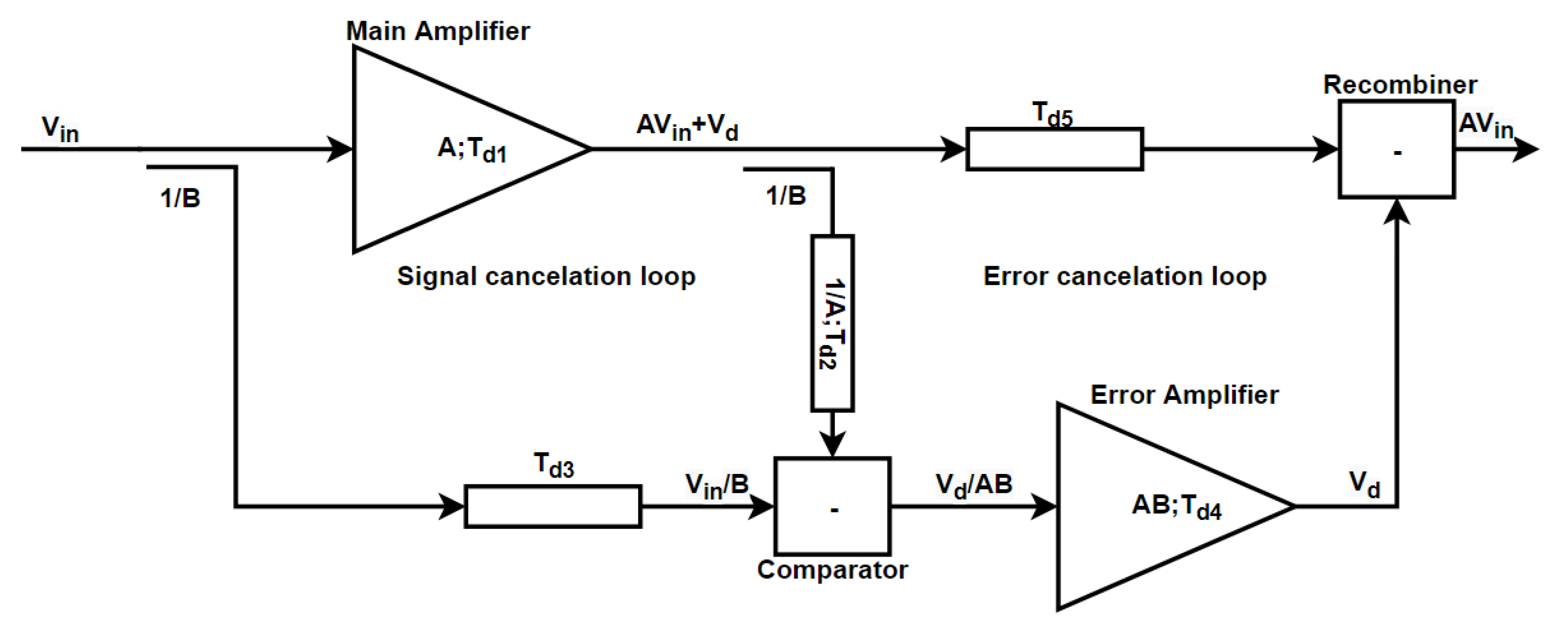
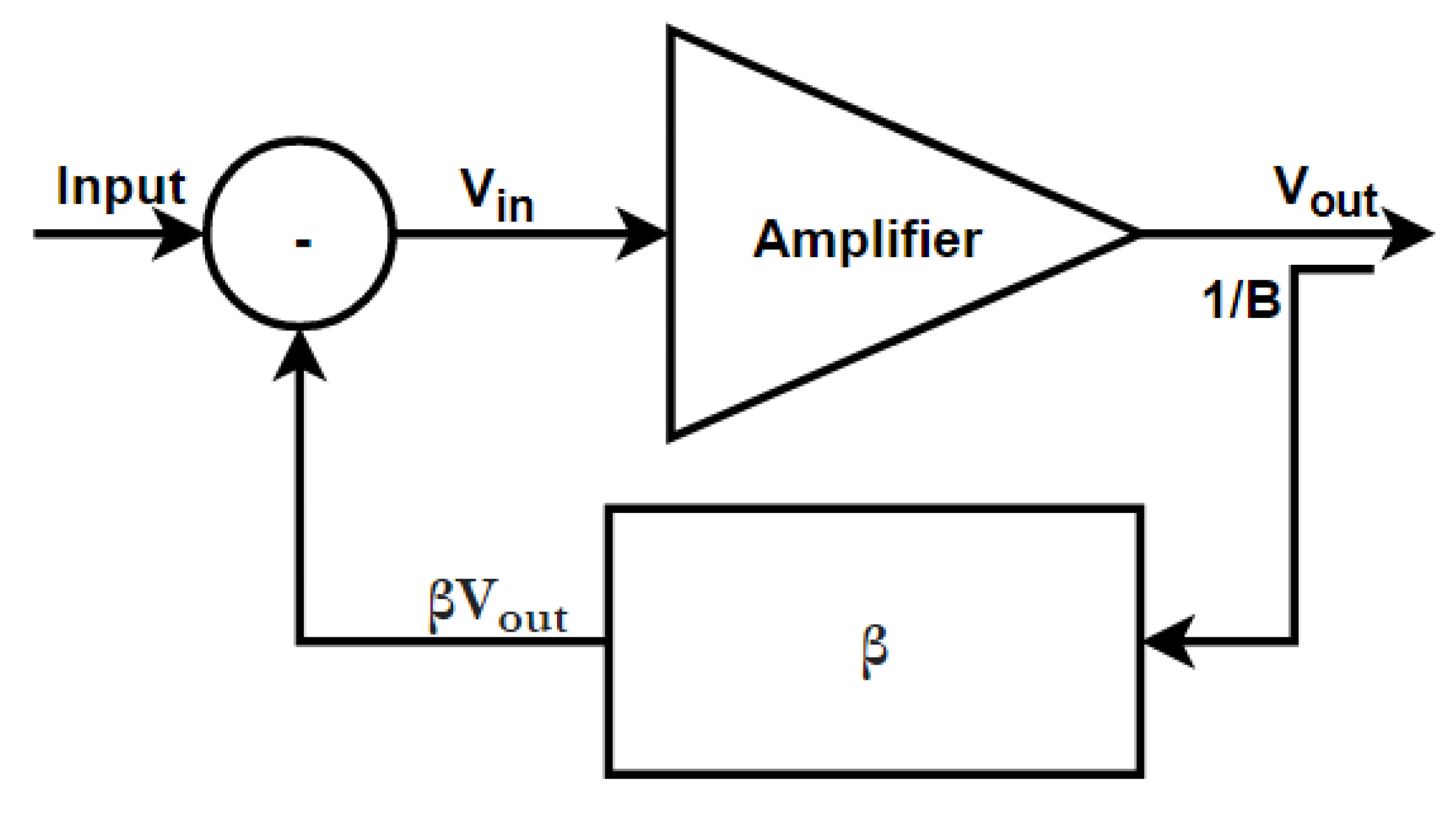
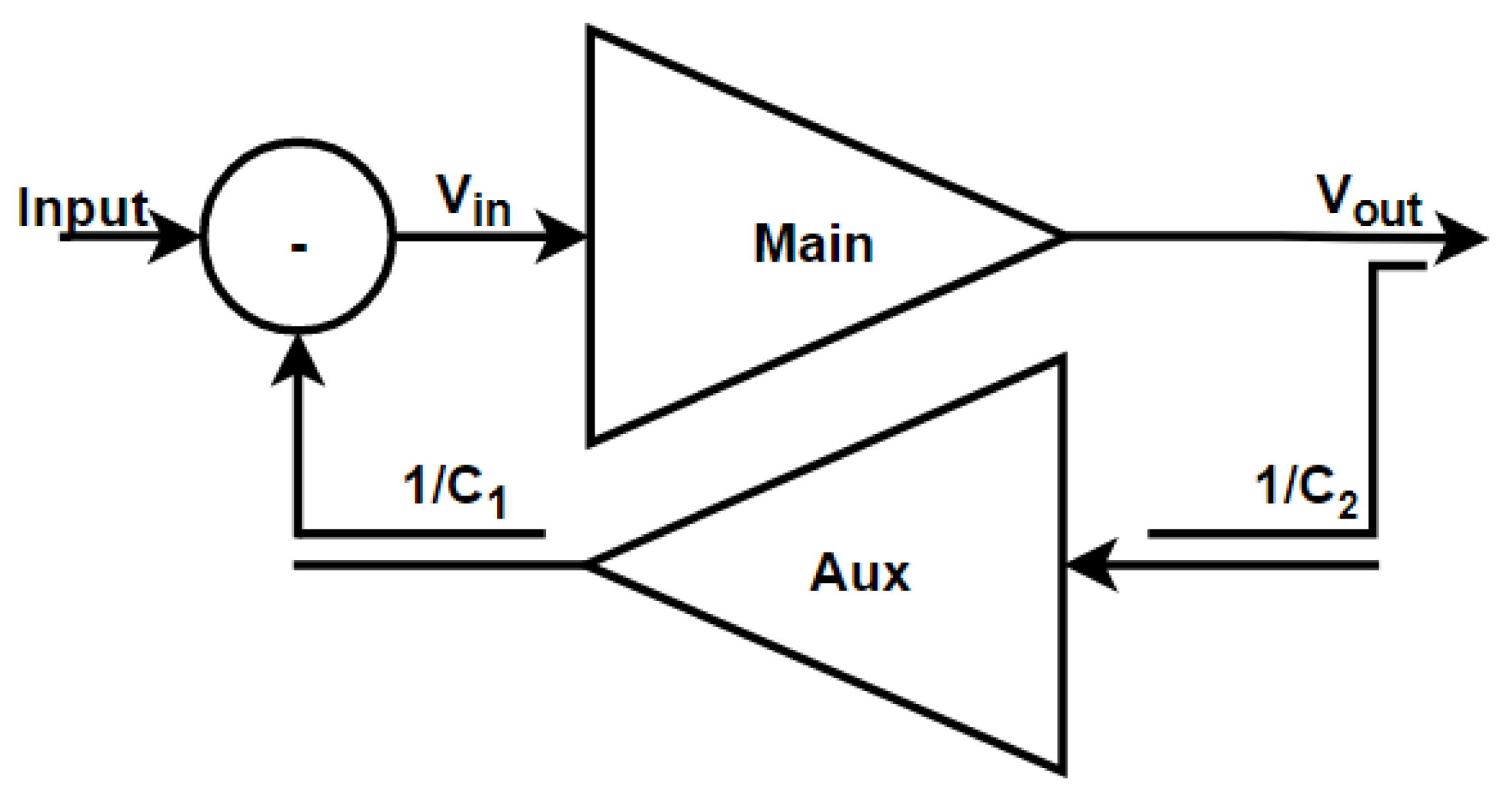


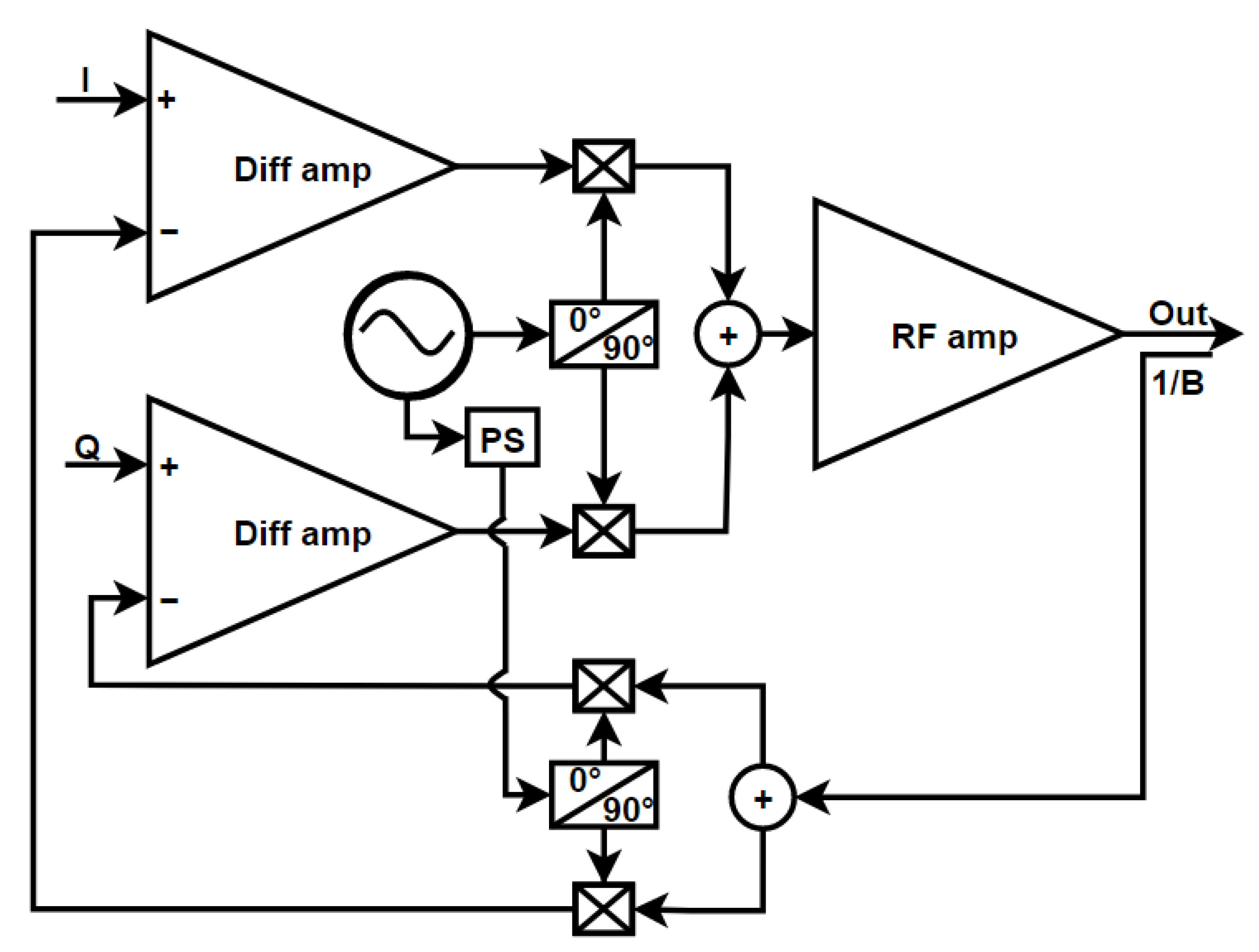

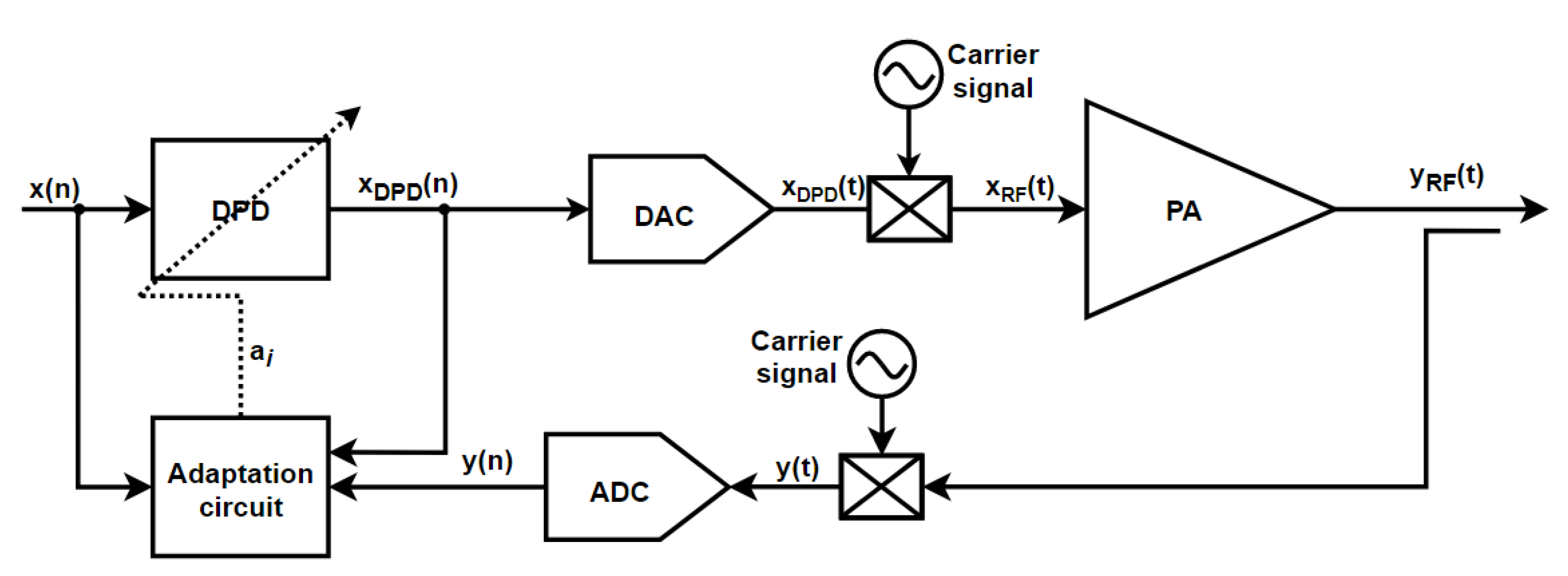

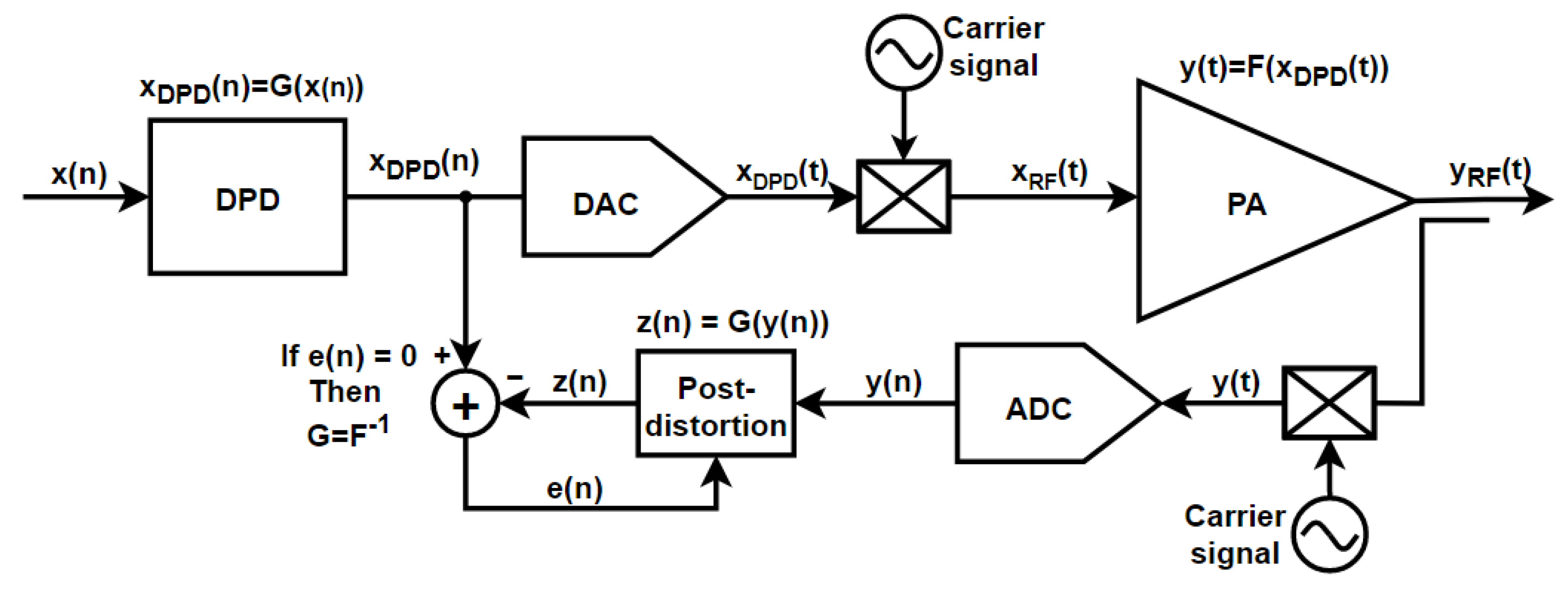
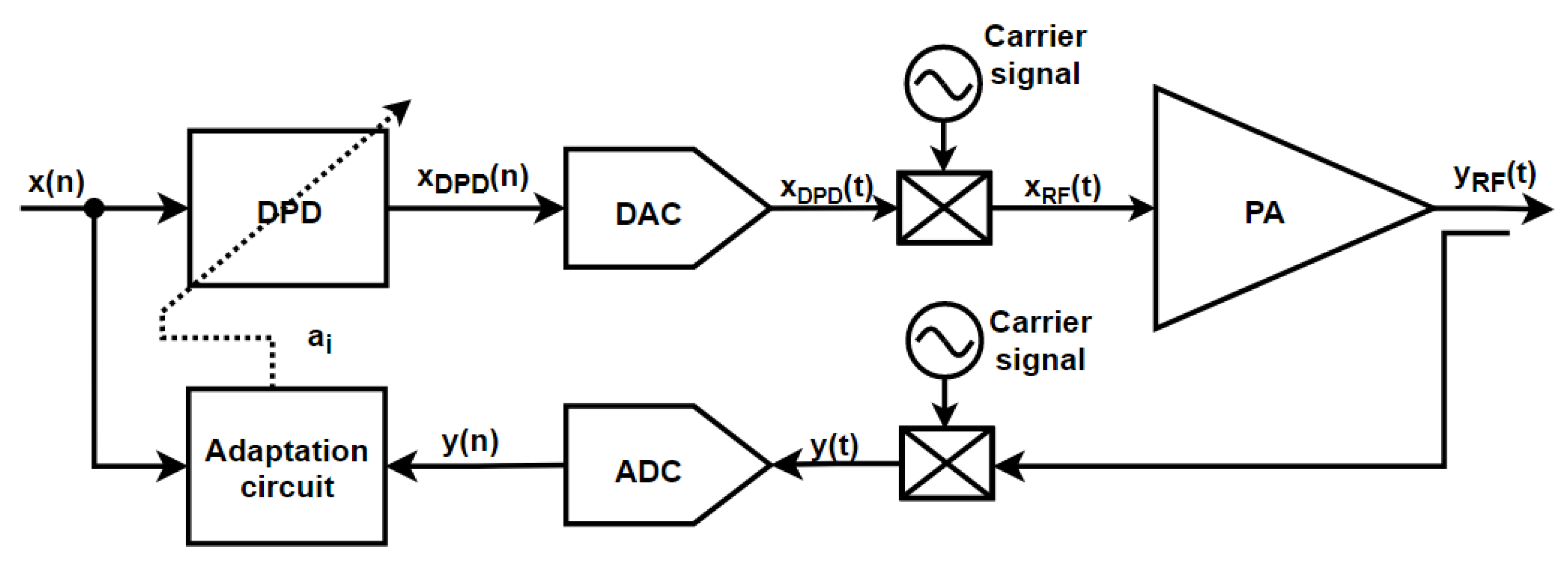


| Source | Year | Output Power (dBm) | Efficiency | ACLR (Lowest) dBc | Frequency (MHz) | Test Signal | Bandwidth MHz |
|---|---|---|---|---|---|---|---|
| [14] | 2005 | 44.7 | 10.9% (PAE) | −60.0 | 2140 | WCDMA | 4 |
| [15] | 2009 | 49 | 27.2% | −53.5 * | 945 | Two tone | N/A |
| [16] | 2010 | 43 | 19.4% (PAE) | −53.2 | 2140 | WCDMA | 20 |
| [17] | 2013 | 52.7 | 25.0% | −62.0 | 880 | WCDMA | 10 |
| [18] | 2015 | 51.4 | 21.4% | −63.0 | 880 | WCDMA | 10 |
| Source | Year | Output Power (dBm) | Power Efficiency, % | ACLR (Lowest), dBc | Frequency (MHz) | Test Signal | Band-Width, MHz | RF Transistor Technology |
|---|---|---|---|---|---|---|---|---|
| [48] | 2010 | 15 | 13.2 * | −38.4 | 2000 | 64 QAM | 10 | 130 nm CMOS |
| [35] | 2012 | 27.1 | 28 (PAE) | −40 | 1880 | WCDMA | 5 | 130 nm CMOS |
| [43] | 2015 | 16.6 | N/A | −33.8 | 2400 | 16 QAM LTE | 1.4 | 130 nm CMOS |
| [44] | 2017 | 14.1 | N/A | −35 | 2 | 16 QAM | 2 | 65 nm CMOS |
| [46] | 2019 | 21.4 | 22.3 | −49 | 10000 | WCDMA-UL | 4 | 65 nm CMOS |
| Source | Year | Output Power (dBm) | PAE, % | ACLR (Lowest), dBc | Frequency (MHz) | Test Signal | Bandwidth, MHz | RF Transistor Technology |
|---|---|---|---|---|---|---|---|---|
| [74] | 2010 | 15 | 51 | −42 | 880 | EDGE | 0.2 | HEMT |
| [75] | 2020 | 26.3 | 18.7 (η) | −40 | 900 | 64-QAM | 200 | GaN-HEMT |
| [76] | 2015 | 37.5 | 45 | −48,1 | 1890 | 2-carrier LTE | 40 | N/A |
| [77] | 2013 | 23.3 | 8 | −43,5 | 1950 | LTE | 5 | 65 nm CMOS |
| [78] | 2017 | 46 | 34.6 | −40 * | 2140 | LTE | 20 | LDMOS |
| [79] | 2016 | 35 | 29.8 | −45.9 | 2650 | OFDM | 16 | GaN-HEMT |
| [80] | 2017 | 16.4 | 15.2 | −28.8 | 15,000 | 64-QAM | 200 | SOI CMOS 45 nm |
| [81] | 2019 | 9.8 | 18.2 | −30 | 28,000 | 64-QAM | 340 | CMOS 65 nm |
| [82] | 2011 | 7 | N/A | −21 * | 60,000 | Two tone | 5 | CMOS 90 nm |
| Feedforward | Adaptive Feedforward | Cartesian Feedback | Polar Feedback | Analog Predistortion | Digital Predistortion |
|---|---|---|---|---|---|
| ACLR improvement, dBc | |||||
| 20–24 | 28 | 8–14 | 10 | 6–17 | 3–16 |
| Energy efficiency, % | |||||
| 10–27 | 25 | 13–22 | 28 | 15–18 | 8–51 |
| Bandwidth, MHz | |||||
| 4–20 | 10 | 1–10 | 5 | 200–340 | 1–200 |
| Disadvantages/difficulties | |||||
| Additional power amplifier, dependency on stable operational conditions | Additional power amplifier, additional loop control circuit | Limited bandwidth, additional IQ converters, IQ imbalance, severe bandwidth–gain trade-off, | Additional and expensive phase control circuitry, different amplitude, and phase components spectra | Dependency on stable operational conditions, limited linearization capability | High energy consumption, expensive converters |
| Advantages | |||||
| Relatively high improvement in linearity, relatively high bandwidth | High linearity improvement, high tolerance to change in operational conditions | Improvement in stability conditions over classical feedback, no need of phase locked loop controllers, similar signal component bandwidth, feedback architecture allows self-regulation | Constant amplitude architecture allows us to soften amplifier linearity requirements, feedback architecture allows self-regulation | Relatively easy to implement, possibility to implement at extremely high carrier frequencies and bandwidths | Relatively easy adaptation implementation, versatile architecture |
| Output power level, dBm | |||||
| 43–51 | 52 | 14–21 | 27 | 7–26 | 15–46 |
Publisher’s Note: MDPI stays neutral with regard to jurisdictional claims in published maps and institutional affiliations. |
© 2021 by the authors. Licensee MDPI, Basel, Switzerland. This article is an open access article distributed under the terms and conditions of the Creative Commons Attribution (CC BY) license (https://creativecommons.org/licenses/by/4.0/).
Share and Cite
Borel, A.; Barzdėnas, V.; Vasjanov, A. Linearization as a Solution for Power Amplifier Imperfections: A Review of Methods. Electronics 2021, 10, 1073. https://doi.org/10.3390/electronics10091073
Borel A, Barzdėnas V, Vasjanov A. Linearization as a Solution for Power Amplifier Imperfections: A Review of Methods. Electronics. 2021; 10(9):1073. https://doi.org/10.3390/electronics10091073
Chicago/Turabian StyleBorel, Andžej, Vaidotas Barzdėnas, and Aleksandr Vasjanov. 2021. "Linearization as a Solution for Power Amplifier Imperfections: A Review of Methods" Electronics 10, no. 9: 1073. https://doi.org/10.3390/electronics10091073






